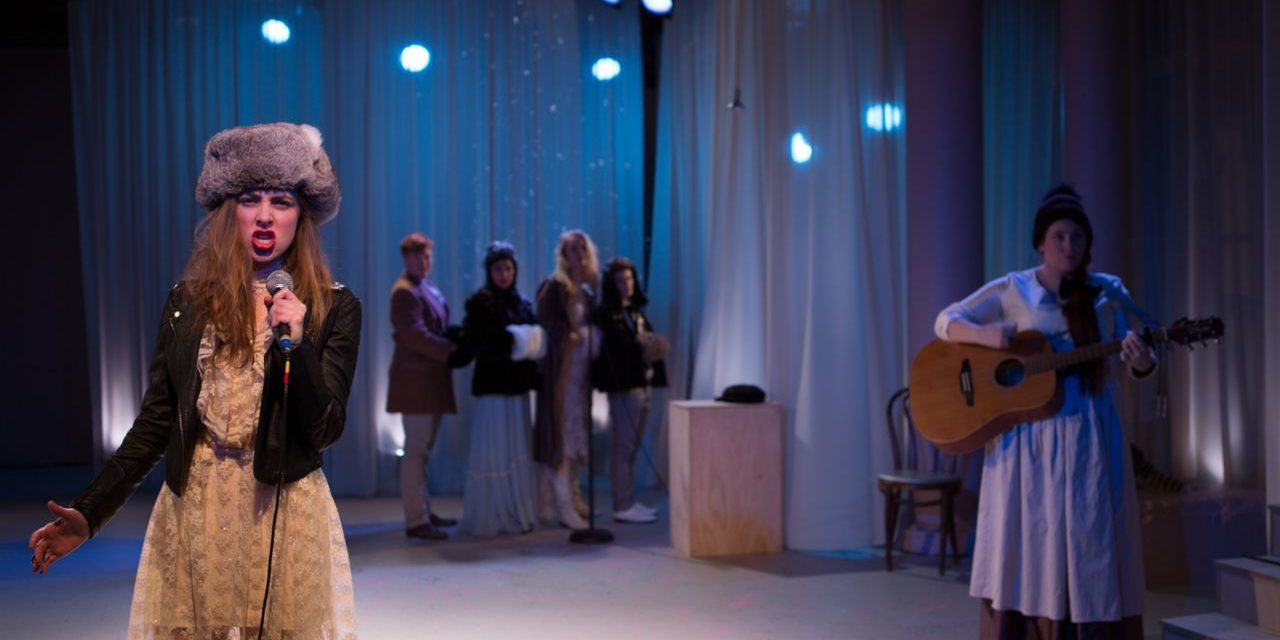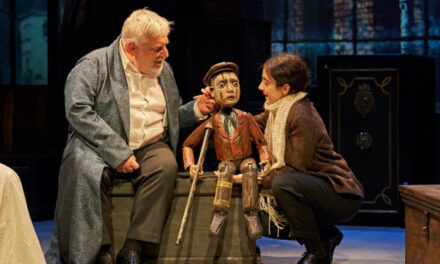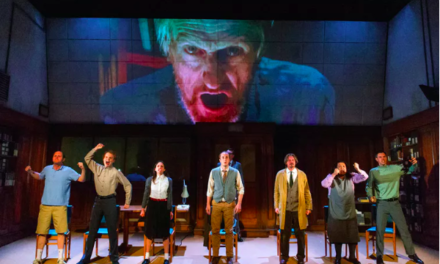Twenty years after the Wooster Group’s seminal Three Sisters-inspired Brace Up!, contemporary New York theatre ensembles Half Straddle and New Saloon put their own postmodern bent on Chekhov’s canonical plays in their respective works Seagull (Thinking Of You) (2013) and Minor Character (2017). These productions, like the Wooster Group’s, use Chekhov as their origin point but differ in dramatic form and performance style. They exist in the same ecosystem of downtown or “experimental” New York and were each developed and performed by a theatre company of at least three collaborators who have worked together extensively before their Chekhov explorations. I do not mean to infer a simple causal-historical relationship among the productions, though the artists in both Half Straddle and New Saloon fall in a direct lineage with the artists, producing organizations, and theatre spaces of the Wooster Group and their contemporaries. Rather, I want to point to how these ensembles (comprised of directors, playwrights, actors, and dramaturgs) work to decentralize dominant acting techniques and thus reformulate how a character can function in theatre performance. Does the destabilization of character, achieved through idiosyncratic performance techniques like gesture and affect, always rupture the absolute nature of the drama? How do we talk about character in terms of acting methodology in postdramatic theatre in the United States?
Half Straddle’s Chekhov Blur
Tina Satter, artistic director of Half Straddle, chose the first of Chekhov’s four major plays to stage anti-naturalist, subversive dramaturgies and acting styles in her play Seagull (Thinking Of You). Satter’s initial connection to Chekhov’s play was both a genuine infatuation with the themes and an identification with the characters in relationship to her own life and artistic practice, describing Nina’s final monologue about being a seagull as “really weird girl magic” (Soloski). Satter uses text from The Seagull, excerpts from Chekhov’s personal letters, and her own writing to construct a play that exists underneath, on top of, in the seams of the original text, exploring, in her own words, “the darkness, beauty, and history of Chekhov’s iconic play…and its resonances with her Half Straddle ensemble.” Her characters are Chekhov’s female characters, Treplov, and a character named Peter (after Sarsgaard, who has much text from Chekhov’s Trigorin). The cast is comprised of women, transmen, and gender non-binary performers. Not all the performers have extensive actor training, though some do. Chekhov and Stanislavski’s system are questioned, subverted, and reframed.
The structure of the performance loosely follows the dramatic trajectory of Chekhov’s text, but embellishes it, like Brace Up!, with new elements like song, choreography, and non-naturalistic blocking, all of which are part of Half Straddle’s practice in their various other plays and videos they make. Also like the Wooster Group’s Chekhov work, Seagull (Thinking Of You) features the presence of Half Straddle’s own interpersonal, artistic, and erotic exchanges. Satter’s intervention on the postdramatic Chekhov, though, rests in a new dramaturgical tactic: the mixing, colliding, and blurring of Chekhov’s characters, their genders, and their sexualities. This technique obscures modernist dramaturgical and acting methodological conventions of character to, as Elinor Fuchs puts it, “undermine the illusion of autonomous character” (Fuchs 31). These shifts in character directly influence the acting style that the cast must utilize in performance, for what might be called the “through line” or “super objective” arcs of the characters in Stanislavski’s system are difficult to track because each actor has lines from multiple Chekhov characters in multiple newly formed relationships. The characters are rearranged, subject to Satter’s authorship, and therefore incoherent and inscrutable.
Early in Satter’s play, Nina (Emily Davis) and Arkadina (Susie Sokol) perform the first Nina/Constantin scene of Chekhov’s text. Nina tells Arkadina the same things she tells Konstantin in Chekhov’s first act: her parents don’t want her to become an actress, she doesn’t like acting in his play because there aren’t any living people in it, nothing happens in it. The heterosexual narrative of Chekhov’s text shifts into a queer, homosocial space. Further, the conversation exists between Nina/Arkadina, Nina/Konstantin, and Emily/Susie all at once. The character is refracted and displaced for audience members who are aware of Chekhov’s original characters and plot. Using Stanislavskian acting methodology, it seems quite difficult to discern a single objective or tactic in this scene because there is not one single relationship occurring in the actor’s bodies. There are multiple. At the end of the play, Nina (Emily) and Treplov (Jess Barbagallo) perform this early Nina/Treplov scene again, in the “proper” characters: the repetition of presenting another example of one of the many wrenches Satter throws into character throughout the play. Here, Satter’s dramaturgy summons Lehmann’s notes on postdramatic theatre: “The text, therefore, is considered only as one element, one layer, or as a ‘material’ of the scenic creation, not as its master” (Lehmann 17). At the same time, the enactment of these scenes maintains the dialogic, modern framework of Chekhov’s original text, even considering these broader devices of casting mashups and repetition. Moments of drama become material for a postdramatic exploration of art, theatre, eroticism, and heartbreak.
Satter writes text that confronts the relationship between acting, representation, and normativity. In addition to Chekhov’s text, the actors speak—as an amalgamation of their Chekhovian character and real identity—argue, chat, and gossip about acting itself (what is considered the best acting, how to memorize lines, who is on book). They rehearse a play—Konstantin’s play to be performed by Nina or Satter’s play to be performed by Half Straddle company members; it’s unclear. This inscrutability ruptures the stability of complete, absolute character. In an intangibly intimate interaction, the two actors (or is it the two characters?) begin their discourse about acting. Masha/Eliza confronts Nina/Emily about her acting:
MASHA: I saw you yesterday. Doing that.
NINA: Doing what?
MASHA: Sitting around. Acting like you were, like, acting. Like channeling pleasure. Or something.
Masha slowly starts to fall to her left, Nina pinches her right arm and brings her back up to standing. (Satter 20)
Satter’s attitude towards acting and emotion seems critical yet inquisitive–what have we been taught to think of as good acting, and how does that align with or deter from what actually is good acting? This question, of performance of identity in relationship to theatrical acting, is a political one, embedded in feminist and queer discourse surrounding the de-essentializing of identity and the representation of socially-learned or socially-necessitated behaviors from women and queer people. In Satter’s play, acting is elusive yet inherently connected to emotion and authenticity. This act of “channeling,” not of “embodying” or “living,” is repeated later in the play when Jess, as Treplov, tells Davis’ Nina: “Some of those stumps do really nuanced work. They’re more in themselves. Channeling charisma–you know–in a really fascinating way. It’s a new kind of acting” (Satter 34). The relationship between the actor and her character, at the intersection of acting style and dramatic structure, aligns and refracts simultaneously; the relationship is destabilized, unnatural, always shifting between Satter’s version of Chekhov’s character and the actor playing them.
In Seagull (Thinking Of You), the performers wink and giggle. They withhold any notion of a “true self” from us, the audience, burying it in a meticulous choreography of adolescence and in their fictionalized versions of themselves. Inscrutability is a key device to both the dramatic restructuring of Chekhov’s text and letters, as well as the performance styles of the ensemble. The ensemble’s performances are marked by a detached vocal tone reminiscent of adolescent girls or juvenile actors, yet the result is not always an ironic detachment from emotion. Satter’s play does not make a judgment on what is and isn’t good acting, but instead makes a critique of naturalistic, “emotional” acting as restrictive of queer potentiality and untrue to the way the women and queers she works with communicate and perform. Satter’s play investigates emotion; it does not reject it. As a result, it creates space for actors, performers, and characters of non-normative or anti-normative identities.
Later, Masha and Nina (channeled by Eliza and Emily) have another conversation about acting in which they lament conventionality and aspire towards a sort of performative utopian, feminine and queer, alternative:
NINA: When I go out there, why can’t it feel like? Why can’t it feel like we don’t have to add on any layer? That we’re just like/
MASHA: Shining?
NINA: Yes, shining!
MASHA: Like your hair––which you know is perfect.
NINA: So is yours! (Satter 35)
Acting, and more broadly performance, possesses a potentiality in Satter’s play for transcending conventionality (in acting, structure, and identity): to shine, to access “girl magic.” The performance is at once an institutional critique of actor training and the commercial theatre industry’s reliance on hyper-trained actors and utopian dream of a world in which the wonders of Stanislavski and Chekhov’s radical theories and texts can be channeled by a cast of women, transmen, and gender non-conforming actors. “Awkwardness” is not a commentary on a culture of detachment and technological isolation, but it’s a portal through with to challenge what Satter calls the “intangible” moments of communication that occurs between women, girls, transmen, and generally outside of cis-male dialogue and discourse.
By the end of the play, Davis and Barbagallo perform a version of the final scene between Nina and Treplov, aligning the actor, Satter’s adapted character, and Chekhov’s original dramaturgy. Davis delivers a highly emotional performance through real tears, the material evidence of an internal emotional process. Treplov/Barbagallo tells her that she is finally shining, and Nina/Davis grabs their arm and confesses the title of the play: “I am always, always thinking of you. And I really hate you. I mean, not that” (Satter 63). In the thick of Satter’s confusing and remixing of character, there is a moment of emotional and dramaturgical clarity when the inscrutable is rendered assailable, legible. A dramaturgy influenced by feminism and queerness does not necessarily need to always confuse the spectator, and it seems here that Satter does not fully indulge in the postdramatic’s negation of plot. In this “thinking of you” moment, the dramatic essence of the work is the most potent and the characters are the most absolute. The drama of Satter’s Chekhovian characters and the drama of the ensemble members themselves reach a sort of climactic catharsis, a release of a crushing, failing queer desire. Perhaps Davis here channels Satter herself, uttering words to name Satter’s intangible romantic and intimate desires for another female (whether that be a lover, a sister, or a friend). Or maybe, Davis and Barbagallo have a romantic or intimate relationship of their own that Satter stages parallel to the Chekhovian drama. Whatever it is, the relationship seems fully embodied, layered, and, for a
moment, clear. Half Straddle, obscuring and complicating a porous relationship between character and actor, stages a subversive, postmodern version of The Seagull.
New Saloon’s Return to Character
In Minor Character (2017), New Saloon preserves character as the central dramaturgical element of their work, and it expands character with six translations of Uncle Vanya by Marian Fell, Laurence Senelick, Paul Schmidt, Carol Rocamora, Google Translate, and Milo Cramer (a company member). Eight actors play Chekhov’s characters in these six translations through several permutations like doubling, tripling, and casting against type in regards to gender, race, and age. The production uses these devices to illuminate differences in meaning that derive from translation, and perhaps the different tones of each character’s psychology. New Saloon does not, however, change the content of Chekhov’s text, and therefore stages variations of absolute versions of Vanya, Sonya, Astrov, Yelena, and each of the other characters in the play. The character itself remains absolute, even if it is represented by multiple performers and multiple translations. The body of the actor is a proxy for the form of each character, and the skeletal dramaturgy of Chekhov’s play is unaltered. A parallel dramaturgy of the ensemble’s relationships and process, a current through the Wooster Group and Half Straddle’s work, is absent from New Saloon’s Chekhovian adaptation. And, significantly, many the actors in the performance are professionally trained actors who are not part of New Saloon’s core ensemble. Thus, the acting style is notably less interested in the task-oriented work of the Wooster Group or the tender inscrutability of Half Straddle. Rather, the actors in Minor Character make polished choices, perform their blocking with precision, and speak with trained voices.
The piece is intricately scored with a layering of text from each trio of actors playing a character: the actors echo each other, interrupt one another with a different translation, they speak their own translations in a jagged unison. An audience member’s ear is tuned into the slightest changes in word choice. One Astrov asks: “And why are we so depressed today?” Another: “What are you so down about?” And the third: “Why’re you so sad today?” In her scene with Yelena, one Sonya asks: “You think I’m foolish, don’t you?” Another: “Do you think I’m being stupid?” The third: “Do you think I’m being silly?” The subtle meaning shifts, accompanied by a meticulous musicality of phrasing and timing, create a textured fabric of each character’s multiple word choices and versions of expression. The ensemble articulates a greater interest in how these multiple translations spoken by multiple actors can change how character functions and changes in different bodies, and how this refractory presentation of character relates to contemporary identity politics. Morgan Green, a core member of the company and the production’s director says in an interview with the Brooklyn Rail and the remaining two-thirds of New Saloon, Milo Cramer and Maddie Wise:
Green: It’s this notion of fractured identity that we’ve clung onto as a crux of the project. That at any given time, we are multiple people talking to ourselves, trying to negotiate which version we are in that moment and reading Chekhov’s plays and feeling empathy for Uncle Vanya. In our play, a young woman plays Uncle Vanya—as do, ya know, two other people. But so, allowing each character to be—
Cramer and Wise: —Complex.
Green: Complex, yeah. (Stess)
Green continues in the interview to discuss the ensemble’s commitment to diversity: “Diversity in race, age, and gender felt essential to this idea of identity being plural, and so that’s why it feels important to this project in particular and to making theater in general” (Stess).
But in terms of dramaturgy and dramatic structure in Minor Character, character is expanded and unpacked yet ultimately stabilized and reinforced as a coherent, complete, and believable entity within the drama. Identity is fluid within the bounds of the characters. By the fourth act of the piece, the ensemble lands on a single translation written by Cramer. In the script, Act 4 is subtitled “Return to Stasis.” In a beautifully convincing performance, Caitlin Morris speaks Cramer’s translated text of Sonya’s final monologue, and at this moment, a young, white, female identity is cemented, resolved, and placed at the center of meaning for the piece. The seduction of character prevails over the trends of postdramatic reformulations and queering of coherence. And while New Saloon might intend to present an intervention into the white, male dramatic canon with a vision of a pluralistic society of many races, genders, and sexualities, the over solidification of character in their dramaturgy ultimately creates a millennial brand of presentational diversity rather than a structural subversion and reimagining of the relationship between dramatic structure and identity politics.
References
Fuchs, Elinor. The Death of Character: Perspectives On Theater After Modernism. Bloomington: Indiana UP, 2010.
Lehmann, Hans-Thies. Postdramatic Theatre. London: Routledge, 2010.
Satter, Tina. Seagull (Thinking Of You): With Away Uniform And Family. New York: 53rd State Press, 2013.
Soloski, Alexis. Half Straddle Wants To Bring You Some Really Weird Girl Magic. Village Voice. 2 Apr. 2016.
Stess, Ariel. 6 Translations, 4 Acts, And 11 Vanyas: New Saloon’s Minor Character. Brooklyn Rail. 5 Apr. 2017.
This post was written by the author in their personal capacity.The opinions expressed in this article are the author’s own and do not reflect the view of The Theatre Times, their staff or collaborators.
This post was written by Michael Breslin.
The views expressed here belong to the author and do not necessarily reflect our views and opinions.


















